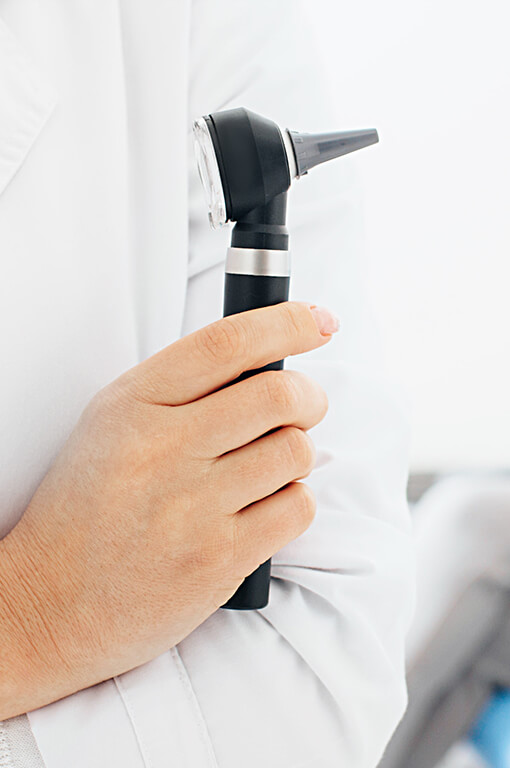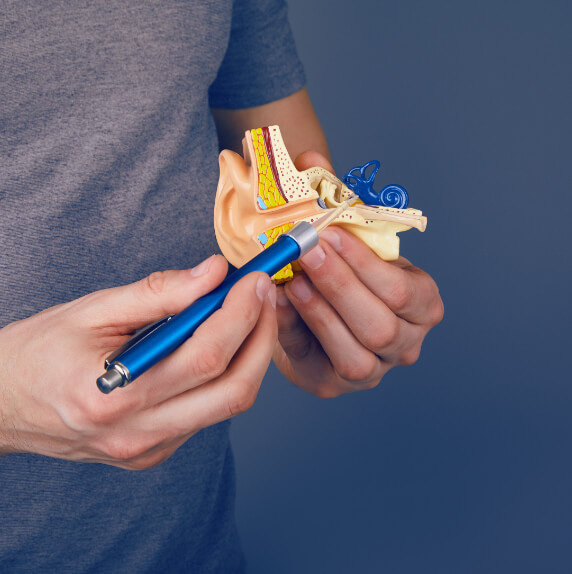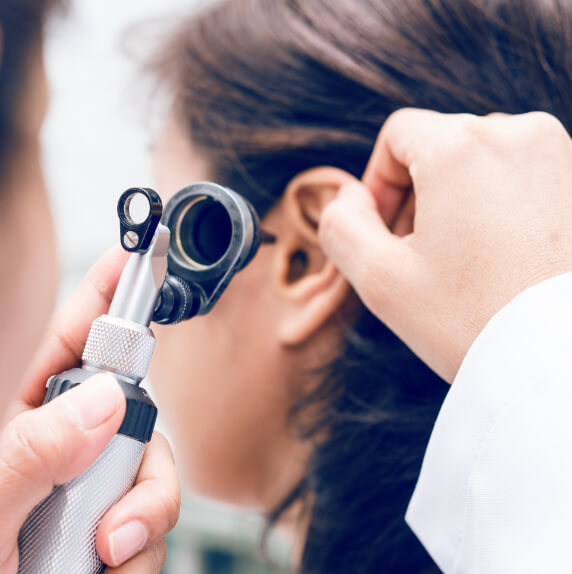
The hear.com online hearing test
Test your hearing. Free and uncomplicated.
In most cases, the signs of hearing loss are subtle: your partner will mention that you’re watching television at really loud volumes. You have difficulty following conversations in a noisy environment, and group conversations are sometimes difficult for you as well. A hearing test can help assess your individual hearing ability and check your own hearing. The only way to determine with absolute certainty whether you have hearing loss is a professional hearing test from a hearing care professional. We will be happy to help you find a competent audiologist near you.
Table of Contents
- Understand your hearing potential
- General information about the hearing test
- Subjective techniques for a hearing test
- Objective hearing test processes
Recognize the potential of your own hearing
After the evaluation of the hearing test you will receive an audiogram, which presents your result in graphic form. This is an easy way to tell which ear and at which frequencies you are showing signs of hearing loss. Human hearing is like a fingerprint: everyone has a different one. While some have problems perceiving high tones, for others it is primarily the low frequencies. The classification of hearing from normal hearing ability through mild, moderate and severe hearing loss to profound hearing loss also helps to assess the performance of one’s own ears.
General information about the hearing test
To check the hearing ability, the ENT doctor can carry out so-called objective as well as subjective test procedures. In addition, it is important that the ear, nose and throat doctor check the anatomical features of your ear canal and can thus detect any occlusion of the ear canal with earwax (cerumen) at an early stage. This is very important as clogged ear canals can lead to incorrect results in the hearing test.
Subjective methods of a hearing test
1. Hearing range test (language distance test)
During the hearing range test, a sound perception test is carried out in both ears. The distance from which spoken numerical words can just be repeated correctly by the test person is measured. The words to be spoken are spoken by the ENT doctor in “normal” colloquial language and in whispered language during the hearing test. The ear that has not been tested is closed so that the ears can be tested independently of each other. Normal hearing is when the test person can correctly reproduce the words spoken from a distance of 6 to 8 meters. The result depends, among other things, on the speaker and room acoustics and is only to be regarded as a rough, orienting measurement, but is nevertheless very meaningful.
2. Tone Audiometry
In tone audiometry, tones of different frequencies (60 to 10,000 Hertz) are generated by a tone generator. The volume is increased until the patient perceives the first sound through headphones. Both the hearing threshold and the discomfort threshold are tested. In the former, the hearing ability is checked via the air conduction of the sound. The latter represents the threshold at which people perceive the sound as unpleasant. Thus, human hearing is limited by two points. Both ears are tested separately and the results are shown in an audiogram.
3. Recruitment measurement
Recruitment measurement can diagnose what is known as sensorineural hearing loss or inner ear hearing loss. This checks whether the test person hears sounds louder or quieter in one ear than in the other. If this is the case, the sensory cells in the hearing organ of the inner ear, for example, may be damaged. You can find more information on sensorineural hearing loss here.
4. Game audiometry
Play/Game audiometry is used for children between the ages of two and four years. In the course of this test, children are asked to carry out a predetermined activity for each tone heard, e.g. laying building blocks on top of one another. In this way, in addition to hearing disorders, possible disorders of speech understanding or development can be determined. In general, the earlier a hearing loss is diagnosed, the better it can be treated. You can find more information on the subject of “hearing loss in children” here..
Objective hearing test procedures
1. Otoacoustic emission
The focus of this test is the inner ear, more precisely the sensory cells of the hearing organ. When sounds in the form of sound waves reach the inner ear, the sensory cells (hair cells) in the inner ear contract. This contraction causes noises, the so-called otoacoustic emissions, which can be perceived by the measurement microphones placed in the external auditory canal.
2. Stapedius reflex test
In this hearing test, one ear is exposed to very high volume, whereupon the stapedius muscle contracts. The result is the tension in the ossicles, which is measured and which can be used to differentiate between different types of hearing loss.
3. Tympanometry
With tympanometry, a measuring probe is first placed in the external auditory canal, which seals the external auditory canal. With this probe test tones of different frequencies and sound levels can be emitted and measured. Normal pressure, positive pressure and negative pressure are then generated one after the other, which leads to changes in tension in the ossicular chain and in the eardrum. So you can measure the portion of the sound reflected on the eardrum at normal, positive and negative pressure and thus indirectly determine the pressure in the middle ear. The pressure in the middle ear can indicate, for example, pathological contents of the middle ear or disorders within the ossicular chain.
4. Electrical reaction audiometry
This type of hearing test is primarily suitable for infants and test persons who cannot give any signs in a “normal” hearing test. It is therefore not based on the information provided by the person being tested, but on the activation of brain cells by acoustic stimuli. This is determined by electrodes on the forehead or scalp.





